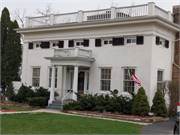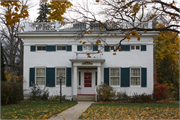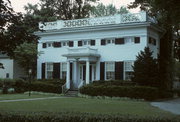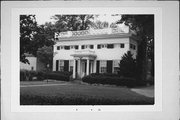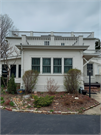Property Record
117 E STATE ST
Architecture and History Inventory
| Historic Name: | Origen & Julia Ann Perkins House |
|---|---|
| Other Name: | |
| Contributing: | Yes |
| Reference Number: | 10671 |
| Location (Address): | 117 E STATE ST |
|---|---|
| County: | Racine |
| City: | Burlington |
| Township/Village: | |
| Unincorporated Community: | |
| Town: | |
| Range: | |
| Direction: | |
| Section: | |
| Quarter Section: | |
| Quarter/Quarter Section: |
| Year Built: | 1846 |
|---|---|
| Additions: | |
| Survey Date: | 19752011 |
| Historic Use: | house |
| Architectural Style: | Greek Revival |
| Structural System: | Stone |
| Wall Material: | Stucco |
| Architect: | |
| Other Buildings On Site: | |
| Demolished?: | No |
| Demolished Date: |
| National/State Register Listing Name: | Kane Street Historic District |
|---|---|
| National Register Listing Date: | 7/25/2014 |
| State Register Listing Date: | 11/22/2013 |
| National Register Multiple Property Name: |
| Additional Information: | A 'site file' exists for this property. It contains additional information such as correspondence, newspaper clippings, or historical information. It is a public record and may be viewed in person at the Wisconsin Historical Society, Division of Historic Preservation. Origen Perkins, son of Ephraim, was born in 1801 in Mansfield, Connecticut, and migrated with his family to Trenton, New York, in 1802 and Joliet, Illinois, by 1812. There he taught school for a brief period of time before going to Texas and the Caribbean. He returned to farm in Trenton and married Maria Salina Stanton in 1829. After Maria’s death, he married Julia Ann Dyer, sister of Dr. Edward Galusha Dyer, in 1833. He settled in Burlington around 1837. He constructed a non-extant log cabin on the site of present-day Athletic Park. During the mid-1840s, he was a stockholder in the abolitionist newspaper, the American Free Man, published in Milwaukee and later Waukesha. The American Free Man was one of the first abolitionist newspapers in the Midwest and had agents finding sympathetic supporters and delivering the paper throughout Racine and Kenosha Counties. In 1846, Origen Perkins constructed a stone house at 117 E. State Street that is believed to have sheltered fugitive slaves as a part of the Underground Railroad. Having left for California during the gold rush in 1850, Origen Perkins was robbed and murdered on his return to Burlington in 1853. Frederick Stanton Perkins, son of Origen and Maria Salina Perkins, was born in Trenton, New York, in 1832. He settled in Burlington with his family around 1837. Sent to school in New York City in 1842, he returned to Burlington prior to his father’s death in 1853, at which time he inherited the family’s homestead, at 117 E. State Street, including an extensive amount of land from State Street to Market Street between Kane and Pine Streets. By the end of 1853, he returned to New York to study art and, within two years, moved to the Adirondack wilderness to pursue painting landscapes. However, he returned to Burlington around 1856. He moved to Milwaukee in 1860 and established himself as a portrait painter whose clients included bankers, industrialists, and railroad magnates. He returned to Burlington during the Civil War to manage the family farm. During this time, he married Emily Wainwright. After Emily’s death in 1888, he married Sarah Starkey that same year. While painting in the East Coast during the 1850s, he gained an interest for anthropology. He soon began to avidly collect prehistoric American Indian stone artifacts. During the early 1870s, he started running ads in the Burlington newspapers seeking Indian artifacts to purchase. He expanded into collecting all relics, made of stone, flint, or copper and began placing ads in newspapers across the state. His collection, which numbered over 9,000 objects, was first discovered by the academic world in 1875 when a University of Wisconsin professor met Perkins by chance while lecturing in Burlington. Perkins soon sold 8,000 of his items to the state for $4,000; he was also made vice-president of the State Historical Society. Around 1890, he sold 449 copper objects to the Smithsonian Museum of National History for $7,000. Mastodon tusks and other fossils that were found in Dover and purchased by Perkins were sold to the Milwaukee Public Museum. He sold some of his best pieces to European collections. Covered with extensive orchards, Frederick Stanton Perkins sold his family’s land in 1896 to be developed as residential lots. Streets in this area are named after members of his family, including Alice, Edward, Frederick, Henry, Mary, and Robert Streets; Perkins Boulevard; and Wainwright Avenue. Portions of this land along Edward, Kane, and State Streets and Perkins Boulevard make up a substantial portion of the proposed Kane Street Historic District. By the time of his death in 1899, Frederick Stanton Perkins had amassed a collection of nearly 50,000 artifacts and reproduced more than 1,200 of them in paintings, replicating their exact size, form, markings, and delicate variations in color. Of the remaining collection, several hundred pieces went to Beloit College; the rest being sold to a private collector in Racine. ROMAN STYLE BALUSTRADE ON ROOF. FRIEZE WINDOWS. PILASTERS. CLASSICAL ENTRY. Other owners over the years have included Charles Dyer Norton, grandson of Dr. Edward G. Dyer and Secretary to President William Howard Taft, and his wife, Katherine McKim Garrison, a granddaughter of well-known abolitionists William Lloyd Garrison and James Miller McKim. Other owners have been Charles and Dorothy Rohr, Gustave P. and Lettie Luetten, Charles B. "Ceb" and Ellen McCanna, and Dean and Margaret Hancock. |
|---|---|
| Bibliographic References: | RACINE JOURNAL TIMES 9/22/1996. Burlington Standard Press Centennial edition, Part 3, 1963. Burlington Standard Press 11/27/1985. The Underground Railroad in Burlington and Vicinity, Burlington Historical Society, 2002, pp. 6-7. General Files. On file at the Burlington Historical Society, Burlington, Wisconsin. |
| Wisconsin Architecture and History Inventory, State Historic Preservation Office, Wisconsin Historical Society, Madison, Wisconsin |

